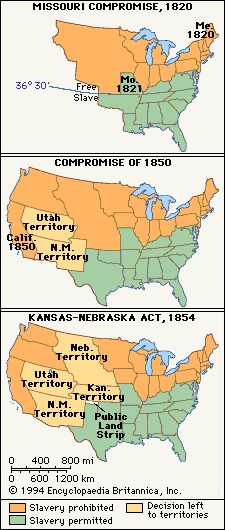1850, Compromise of
United States history
 series of compromise measures passed by the U.S. Congress in an effort to settle several outstanding slavery issues and to avert the threat of dissolution of the Union. The crisis arose from the request of the territory of California (Dec. 3, 1849) to be admitted to the Union with a constitution prohibiting slavery. The problem was complicated by the unresolved question of slavery's extension into other areas ceded by Mexico the preceding year.
series of compromise measures passed by the U.S. Congress in an effort to settle several outstanding slavery issues and to avert the threat of dissolution of the Union. The crisis arose from the request of the territory of California (Dec. 3, 1849) to be admitted to the Union with a constitution prohibiting slavery. The problem was complicated by the unresolved question of slavery's extension into other areas ceded by Mexico the preceding year.To maintain an even balance between free and slave states, a series of measures was offered by the “great compromiser,” Senator Henry Clay (Clay, Henry) of Kentucky. In an attempt to give satisfaction to both proslavery and antislavery forces, the important sections of the omnibus bill called for the admission of California as a free state, the organization of the territories of New Mexico and Utah with the slavery question left open (see popular sovereignty), settlement of the Texas–New Mexico boundary dispute, a more rigorous provision for the return of runaway slaves, and the prohibition of the slave trade in the District of Columbia.
With the influential support of Senator Daniel Webster (Webster, Daniel) and the concerted unifying efforts of Senator Stephen A. Douglas (Douglas, Stephen A), the five compromise measures were enacted in September. These measures were accepted by moderates in all sections of the country, and the secession of the South was postponed for a decade. The Compromise, however, contained the seeds of future discord. The precedent of popular sovereignty led to a demand for a similar provision for the Kansas Territory in 1854, causing bitterness and violence there (see Bleeding Kansas). Furthermore, the application of the new Fugitive Slave Act (Fugitive Slave Acts) triggered such a strong reaction throughout the North that many moderate antislavery elements became determined opponents of any further extension of slavery into the territories. While the Compromise of 1850 succeeded as a temporary expedient, it also proved the failure of compromise as a permanent political solution when vital sectional interests were at stake.
- Stans, Diet of
- Stanthorpe
- Stanton, Edwin M
- Stanton, Elizabeth Cady
- Stanton, Frank
- Stanton Macdonald-Wright
- Stanwyck, Barbara
- stanza
- staphylococcus
- Stapledon, Olaf
- Stapledon, Sir George
- Staple Singers, the
- star
- Starachowice
- star apple
- Staraya Russa
- Stara Zagora
- Starbuck Island
- star catalog
- starch
- Star Chamber, Court of
- Starck, Philippe
- star cluster
- Stardust/NExT
- stare decisis